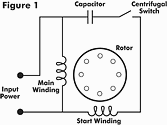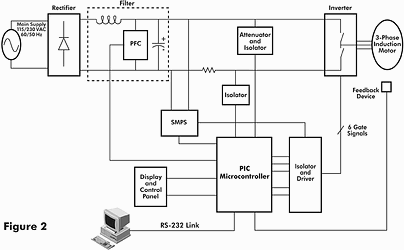
Today, electric motors, and particularly AC induction motors (ACIM), are widely used in domestic appliances, ranging from refrigerators and microwave ovens to washing machines and tumble dryers. A typical single-phase ACIM design is shown in Figure 1.

The modified split-phase motor shown has a capacitor in series with the start winding to provide a starting 'boost'. A centrifugal switch disconnects this capacitor and the start winding once the motor has reached around 75% of its target speed. Often, these motors will have multiple windings to accommodate the need for different speeds of operation.
In this type of circuit, the motor is connected directly to the mains input, so the voltage and frequency are constant. This means that in many cases the motor will be over-designed for peak performance. The result is an inefficient driving system that will often be generating more torque than is required by the load.
A problem that occurs in such systems is that the power factor (PF) is very low when the motor is operated at light loads. This degrades the quality of the power on the mains supply and can affect the performance of other equipment connected to the same line. Power distribution companies have started to set limits on the value of power factor at which their customers can draw power, and are imposing penalties on those who do not meet the requirements, so power factor is today a very important parameter for domestic appliances. The choice for the user is to use equipment that controls the power factor, maintain a full-load condition on equipment even when it is not needed, or to pay the penalty for the light-load condition.
Another problem that can be experienced is the possibility of a surge or sag of the supply to the appliance, caused by other equipment working on the same line. If the motor is not protected from these conditions, it will be subjected to higher stress than necessary, which can lead to its failure far sooner than would otherwise be the case.
The solution to these problems lies in intelligent motor control. Recent developments in microcontroller technology have produced devices that allow motors to be controlled more efficiently, while reducing noise and the costs at the component level. Microchip Technology recently introduced four 8-bit PICmicro MCUs known as the PIC18Fxx31 family. This family incorporates several new specialised motor control peripherals, including a power control pulse width modulation (PWM) module, a 200 kSaps analog-to-digital converter that can be synchronised with the PWM, and a motion feedback module. These features not only make intelligent-electronic motor control possible, but also simplify the system design process. Figure 2 shows a typical three-phase ACIM design using one of these new MCUs.

The variable-frequency drive (VFD), shown in Figure 2, is the most popular electronic control for ACIM. An additional benefit is that it allows users to drive a three-phase ACIM using a single-phase supply.
The VFD acts as a variable frequency generator, allowing the user to set the speed of the motor. Firstly, the rectifier and the filter convert the AC input to DC with very low ripple. Then the inverter, under the control of the PICmicro MCU, synthesises the DC into three-phase variable voltage, variable frequency AC. A number of additional features can be implemented, such as DC-bus voltage sensing, over-voltage and under-voltage trip, over-current protection, accurate speed/position control, temperature control, easy control setting, display, PC connectivity for realtime monitoring, and power factor correction.
A single VFD can control multiple motors, is adaptable to almost any operating condition, and eliminates the need to warm up the motor. For a given power rating, the control and the drive provided by the VFD depend solely on the algorithm written into it. This means that the same VFD can be used for a wide range of power ratings. The problems associated with conventional motor control are eliminated.
A PIC18Fxx31 device integrates all control functions needed for such a VFD, and can offer improved motor reliability, reduced noise and extended life. The most significant benefit is an efficiency improvement of up to 30% in many domestic appliances.
Additional resources for electronic motor control can be found on Microchip's web site at www.microchip.com/motor.
For more information contact TempeTech, 011 452 0534 or local Microchip Distributors, Arrow Altech Distribution, 011 923 9600, Avnet Kopp, 011 809 6100 or Memec SA, 011 897 8600.
| Tel: | +27 11 923 9600 |
| Email: | [email protected] |
| www: | www.altronarrow.com |
| Articles: | More information and articles about Altron Arrow |

© Technews Publishing (Pty) Ltd | All Rights Reserved